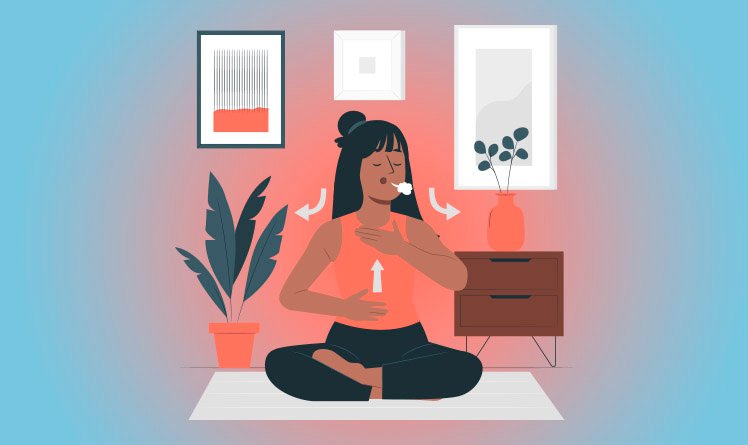Conscious breathing: what it is and how to do it

|
Getting your Trinity Audio player ready...
|
Breathing is so automatic that we rarely stop to pay attention to it. But what if I told you that by becoming aware of your breathing, you can completely transform your mental, physical, and even emotional state? Sounds like an exaggeration? It's not. This is the essence of conscious breathing—an ancient, simple, and powerful practice capable of rebalancing your body, calming your mind, and restoring focus in a matter of minutes.
After all, nowadays, stress has become routine and anxiety disguises itself as productivity. Conscious breathing appears as an anchor: it pulls us back to the here and now. More than a wellness technique, it's a tool for self-knowledge, self-control, and personal transformation. And best of all: you don't need any equipment, apps, or gurus to get started. Just the air that's already there with you.
Let's better understand what this practice is, why it works and how you can incorporate it into your daily life.
What is conscious breathing?
Difference between breathing and being aware of breathing
Everyone breathes. It's obvious, isn't it? But not everyone is aware that they're breathing. Conscious breathing happens when you purposefully bring your attention to the act of inhaling and exhaling. It sounds simple—and it is—but this small gesture can profoundly alter the functioning of your body and mind.
When you pay attention to your breathing, you activate brain regions linked to emotional self-regulation and presence. In other words, you leave "automatic mode" and enter "conscious mode." And that changes everything. Because, in this mode, you gain power over your reactions, your thoughts, and even your health.
“Mindful breathing is the act of bringing your attention to your inhale and exhale, moving out of 'automatic mode' and into 'conscious mode'.”
Origin and foundations of the practice
Conscious breathing has deep roots in Eastern traditions, especially yoga, Buddhist meditation, and Taoist practices. However, the West has begun to take a serious interest in it in recent decades, driven by scientific studies proving its therapeutic effects.
From a Neuro-Linguistic Programming (NLP) perspective, conscious breathing is a bridge between body and mind. It provides direct access to the autonomic nervous system, capable of reprogramming negative emotional states and bringing new ones. mental associations more positive and productive.
Why is conscious breathing so powerful?
Connection with the autonomic nervous system
The key to the power of conscious breathing lies in the autonomic nervous system—the set of involuntary processes that regulate vital functions such as heartbeat, digestion, and stress response. This system is divided into two branches: the sympathetic nervous system (responsible for alertness and fight-or-flight) and the parasympathetic nervous system (related to relaxation and recovery).
So, when we breathe consciously, we activate the parasympathetic nervous system. This slows our heart rate, lowers blood pressure, and signals to the body that everything is okay. In short? We send a safety message to the brain. And it responds by reducing stress levels. cortisol and promoting balance.
Impacts on mental and physical well-being
Besides physiological, the impact of conscious breathing is emotional. Studies show that it helps with emotional regulation, improves working memory, increases mental clarity, and even strengthens the immune system. Not to mention the connection with the body—something many people lose in the hustle and bustle of everyday life. Therefore, by focusing on breathing, we return to inhabiting our bodies with presence and awareness. This, in itself, is immensely valuable.
Proven benefits of conscious breathing
Reduced stress and anxiety
This is one of the most searched answers on Google: “Does conscious breathing work for anxiety?” And the answer is clear: yes, it works. The practice has proven effects in reducing symptoms of anxiety and stress. This happens because it slows the breathing rate and, with it, the flow of accelerated thoughts—that "chattering mind” that leaves us agitated and restless.
Mental clarity and focus
Conscious breathing helps calm mental fog. It brings us back to the present, reducing internal and external distractions. This translates into greater focus, increased productivity, and a much greater ability to make assertive decisions. For those who feel like their mind is in "a thousand open tabs mode," this practice is practically a cognitive detox.
Better sleep quality
Breathing consciously before sleep is like preparing the ground for a deep and restorative sleepTechniques like 4-7-8 breathing activate the parasympathetic system and induce the body into a state of relaxation. It's as if you've put your nervous system into "airplane mode," ready to regenerate.
How to practice conscious breathing
Simple step by step for beginners
Want to get started right now? Close your eyes, if you can, and follow this short script:
- Sit or lie down in a comfortable position.
- Inhale deeply through your nose, counting to 4.
- Hold your breath for 2 seconds.
- Exhale slowly through your mouth, counting to 6.
- Repeat for 2 to 5 minutes, focusing only on the air moving in and out.
If your mind wanders—and it will—just gently return your attention to your breathing. This simple exercise is already a workout. mindfulness.
Popular techniques: 4-7-8, square and diaphragmatic breathing
Breathing 4-7-8 It is excellent for calming and inducing sleep: inhale for 4 seconds, hold for 7 and exhale for 8.
Breathing square (box breathing), used by military personnel and high-performance athletes, involves inhaling, holding, exhaling, and holding—each step lasting the same amount of time (e.g., 4 seconds each).
Already the diaphragmatic breathing (or abdominal) focuses on expanding the belly rather than the chest. It's ideal for those seeking a deeper, more relaxing practice. In fact, by activating the diaphragm, you directly access the parasympathetic nervous system.
How to incorporate it into your daily life
You don't need a meditation cushion to breathe consciously. You can practice while commuting, in the shower, before a meeting, or during a work break. The key is to remember that your breath is always with you—and that it can be your reset button whenever you need it.
Conscious breathing and Mindfulness
How Breathing Anchors the Present Moment
Breathing is one of the pillars of the practice of Mindfulness precisely because it is a powerful anchor. It is always here, in the now. Thus, by focusing on breathing, we automatically escape ruminating thoughts of the past or anxious projections of the future. In this way, we connect with the only real time: the present.
Practical mindfulness exercise with breathing
Try this exercise:
- Sit with your spine straight.
- Close your eyes.
- Breathe naturally.
- Just notice: the cool air entering your nostrils, the slight movement of your abdomen, the subtle sound of air being released.
- Every time a thought comes, just acknowledge it and return your focus to your breathing.
Five minutes of this can already transform your internal state.
Tips for making conscious breathing a habit
Triggers, routines and rewards
Use the habit formula: Trigger + Routine + Reward.
- Kitten: something that reminds you to breathe (it could be an alarm, a post-it, or your coffee break).
- Routine: the breathing exercise itself.
- Reward: the immediate well-being you feel after just a few minutes.
This structure helps the brain automate new behavior more easily.
The role of repetition and consistency
Just like training a muscle, training the mind requires consistency. So, don't expect perfection—expect presence. So, even if you practice for two minutes a day, the cumulative effect is transformative. And if you forget one day, that's okay. Take a deep breath and start over. The most important thing is to keep coming back.
In short…
Conscious breathing is both simple and revolutionary. In this sense, it's a reminder that you already possess within you a tool capable of transforming your mental, emotional, and physical state—without needing anything external. Furthermore, it's an invitation to reconnect with your own essence, with the silence that dwells within your body, and with the wisdom that resides in every cell.
In such noisy times, breathing consciously is an act of courage. A way of saying: “I choose to be present. I choose to take care of myself.”
So the next time the world feels like too much, your mind is racing, or your heart is pounding… stop. Breathe in. Breathe out. And come back to yourself.
Frequently Asked Questions about Conscious Breathing (FAQ)
1. What is conscious breathing in a nutshell?
It is the practice of directing your attention to the act of breathing, intentionally and without judgment.
2. Is conscious breathing the same as meditation?
Not exactly. Conscious breathing can be a technique within meditation, but it can also be practiced in isolation.
3. How many minutes a day should I practice?
Between 5 and 10 minutes are enough to notice benefits, but the more frequent, the better.
4. Who can practice conscious breathing?
Anyone! Including children, the elderly, and people with anxiety, insomnia, or chronic stress.
5. Can I use conscious breathing in times of crisis?
Yes! It's extremely effective for controlling anxiety attacks, stress spikes, and moments of emotional tension.
Image: Freepik

Marcel Castilho is an expert in neuromarketing, neuroscience, mindfulness and positive psychology. In addition to being an advertiser, he also has a Master's degree in NLP – Neurolinguistic Programming. As the owner and founder of the communications agency VeroCom and also of the digital agency Vero Contents, he has been studying human behavior for over 30 years.

